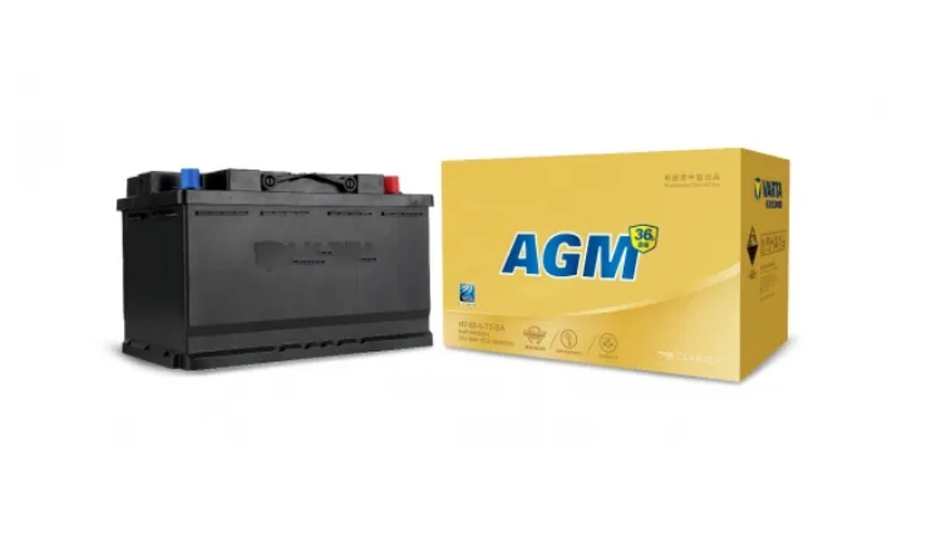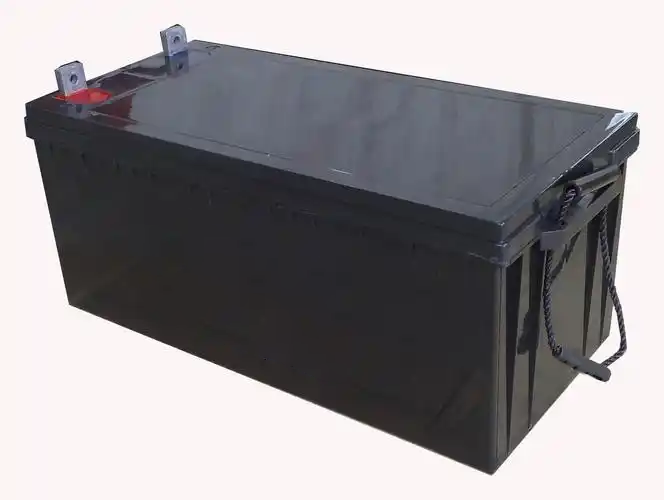 |
Welcome To Evlithium Best Store For Lithium Iron Phosphate (LiFePO4) Battery |
 |

An Absorbent Glass Mat (AGM) battery is a type of lead-acid battery designed to provide several benefits over traditional flooded lead-acid batteries.
Absorbent Glass Mat Technology: AGM batteries utilize thin fiberglass mats between the plates, absorbing and holding the battery’s acid. This design makes the battery spill-proof and maintenance-free, ensuring close contact between electrolyte and plates for improved efficiency.
Sealed Design: Unlike traditional flooded batteries, AGM batteries are sealed, eliminating the need for regular topping up with distilled water and preventing leaks, even if damaged.
Valve-Regulated: These batteries feature a valve to safely release excess gas pressure, ensuring safety during charge and discharge cycles.
High Performance: AGM batteries are renowned for their high performance and durability, handling high power demands with a longer lifespan than conventional flooded batteries.
Deep Cycle Capability: They can be deeply discharged and recharged multiple times, ideal for applications requiring frequent cycling.
Low Self-Discharge: AGM batteries retain charge longer when not in use, thanks to their low self-discharge rate.
Resistance to Vibration and Shock: Their robust design makes them highly resistant to vibration and shock, making them perfect for automotive and marine applications.
Longer lifespan than traditional lead-acid batteries.
Maintenance-free, eliminating the need for water refills.
Spill-proof design ensures no leaks.
Versatile mounting positions.
Lower self-discharge rate.
Higher cost compared to traditional lead-acid batteries.
Sensitive to overcharging, which can reduce lifespan.
Performance can decline in extreme temperatures.
Lower cranking power for high-demand applications.
Automotive: Used in cars, motorcycles, and RVs for starting, lighting, and ignition.
Marine: Ideal for boats and yachts due to their resistance to vibration and deep discharge cycles.
Off-Grid Power Systems: Common in solar power systems and other off-grid applications.
Backup Power: Utilized in uninterruptible power supplies (UPS) and emergency lighting systems.
Industrial and Commercial: Used in forklifts, electric vehicles, and other equipment requiring reliable power.

A Lithium-ion (Li-ion) battery is a rechargeable battery known for its high energy density, lightweight, and long cycle life, making it a preferred choice for portable electronics and electric vehicles.
Electrochemical Composition: Consists of an anode (usually graphite), a cathode (made from lithium compounds), and an electrolyte facilitating lithium ion movement between electrodes.
Intercalation: During charging and discharging, lithium ions move between the anode and cathode through the electrolyte, enabling efficient energy storage.
Sealed Design: The sealed design prevents electrolyte leakage, ensuring safety and reliability.
High Energy Density: Stores significant energy in a compact form, ideal for portable devices.
Lightweight: Lighter than other rechargeable batteries like NiCd or NiMH, reducing overall device weight.
Long Cycle Life: Capable of hundreds to thousands of charge-discharge cycles before significant capacity degradation.
Low Self-Discharge: Retains charge well over time when not in use.
Variety of Form Factors: Available in various shapes and sizes, offering design flexibility.
High energy density allows compact energy storage.
Lightweight and convenient for portable devices.
Rechargeable with a long lifespan.
Low self-discharge rate maintains charge over time.
Environmentally friendly with fewer toxic metals.
Sensitive to extreme temperatures, affecting performance.
Potential fire hazard if mishandled.
Higher manufacturing cost.
Requires protection circuits to prevent overcharging or discharging.
Consumer Electronics: Used in smartphones, laptops, tablets, and wearable devices.
Electric Vehicles: Powers electric cars, buses, and bikes, offering extended driving ranges.
Renewable Energy Storage: Stores energy in solar and wind power systems.
Medical Devices: Powers portable defibrillators, pacemakers, and diagnostic devices.
Industrial Applications: Used in tools, robotics, and industrial machinery.
Aerospace and Defense: Utilized in drones, satellites, and aerospace applications.

Lead-acid batteries are one of the oldest rechargeable battery types, known for reliability, robustness, and high surge currents, making them suitable for automotive and backup power systems.
Electrochemical Composition: Comprises lead dioxide (cathode), sponge lead (anode), and sulfuric acid (electrolyte).
Cell Construction: Each cell produces about 2 volts; cells are connected in series for desired voltage, such as six cells for a 12-volt battery.
Flooded vs. Sealed Design: Available in flooded (wet cell) requiring maintenance and sealed (VRLA) which are maintenance-free.
High Surge Currents: Ideal for applications needing high power output, like starting engines.
Weight: Relatively heavy, which can be a disadvantage in weight-sensitive applications.
Voltage and Capacity: Available in 6V and 12V configurations with various capacities.
Lifespan: Generally lasts 300 to 500 charge-discharge cycles.
Cost-Effective: Lower upfront cost compared to newer battery technologies.
Reliable Performance: Known for reliable performance, especially in high surge current applications.
Ease of Recycling: Highly recyclable with established processes for lead and material recovery.
Reliable with a long history of use.
High power surge capability.
Cost-effective and widely available.
Easy to recycle, making them environmentally friendly.
Heavy and bulky, not ideal for portable devices.
Requires regular maintenance, like adding water.
Limited lifespan with lower charge retention over time.
Contains toxic materials requiring proper disposal.
Automotive: Used in cars, trucks, and motorcycles for starting, lighting, and ignition.
Backup Power: Common in UPS systems and emergency lighting.
Industrial: Used in forklifts and other industrial equipment.
Marine and RV: Provides power for boats and RVs, offering both starting power and deep-cycle capabilities.
Renewable Energy Storage: Used in solar and wind power systems.
Maintenance: AGM and lithium batteries are maintenance-free, while lead-acid batteries require regular maintenance.
Weight and Size: Lithium batteries are lightweight and compact, AGM batteries are heavier and bulkier, and lead-acid batteries are the heaviest.
Temperature Sensitivity: AGM batteries perform better in a wide temperature range, while lithium batteries are sensitive to extremes.
Safety: AGM batteries have low leakage risk, lithium batteries require careful handling, and lead-acid batteries emit gases.
Cost: Lithium batteries are the most expensive, followed by AGM, with lead-acid being the most affordable.
Environmental Impact: AGM and lithium batteries are more environmentally friendly, while lead-acid batteries contain harmful materials.
AGM Batteries: Common in automotive, marine, and backup power systems.
Lithium Batteries: Widely used in portable electronics, electric vehicles, and renewable energy storage.
Lead-Acid Batteries: Preferred for automotive, marine, and industrial applications.
| Characteristics | AGM Battery | Lithium Battery | Lead-Acid Battery |
|---|---|---|---|
| Service Life | 4-6 years | 8-10 years | 4-6 years |
| Weight | 20-30 kg | 10-20 kg | 25-40 kg |
| Size | Larger | Smaller | Larger |
| Operating Temp. Range | -20°C to 50°C | -20°C to 60°C | -10°C to 50°C |
| Safety | Low leakage risk | Stable performance | Risk of leakage |
| Price | $150-300 | $100-2000 | $50-150 |
| Environmental Impact | Recyclable | Environmentally friendly | Recyclable |
| Application | Automotive, Marine | Portable Electronics, EVs | Automotive, Marine |
In summary, each battery type offers unique advantages tailored to specific applications. AGM batteries are versatile and maintenance-free, lithium batteries provide high energy density and long lifespan, and lead-acid batteries are reliable and cost-effective for high-power applications.
Edit by paco
All Rights reserved © 2025 Evlithium Limited